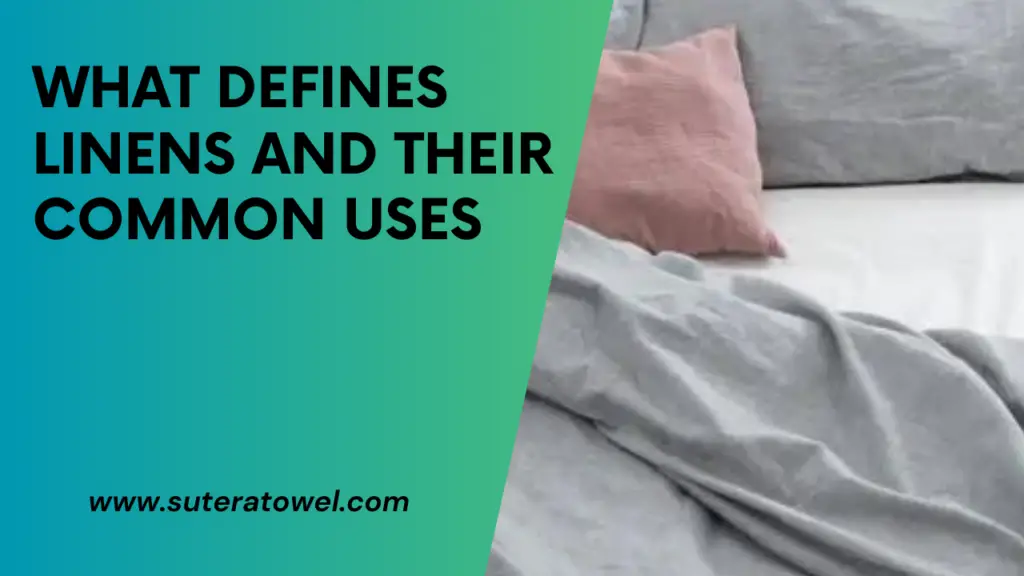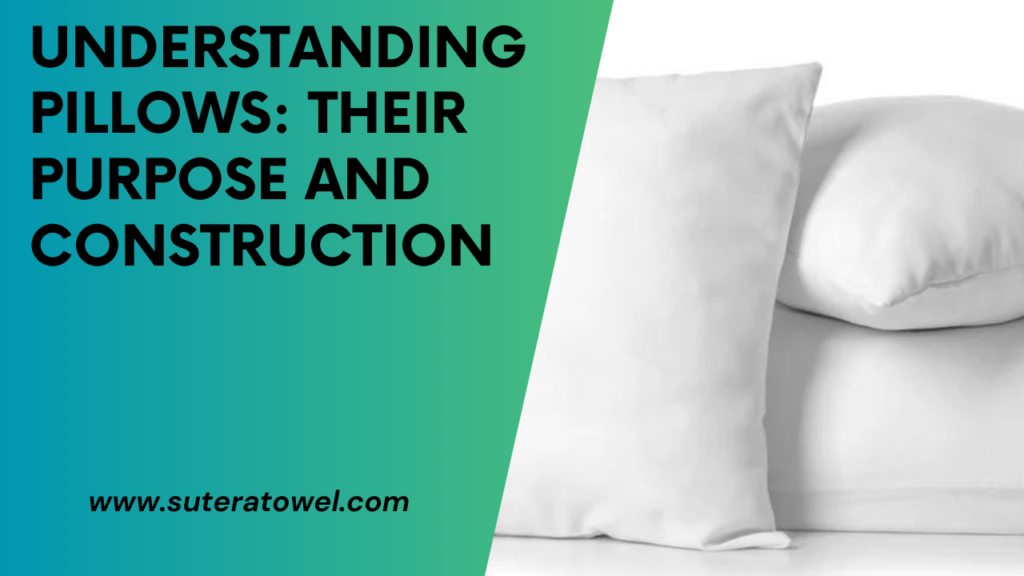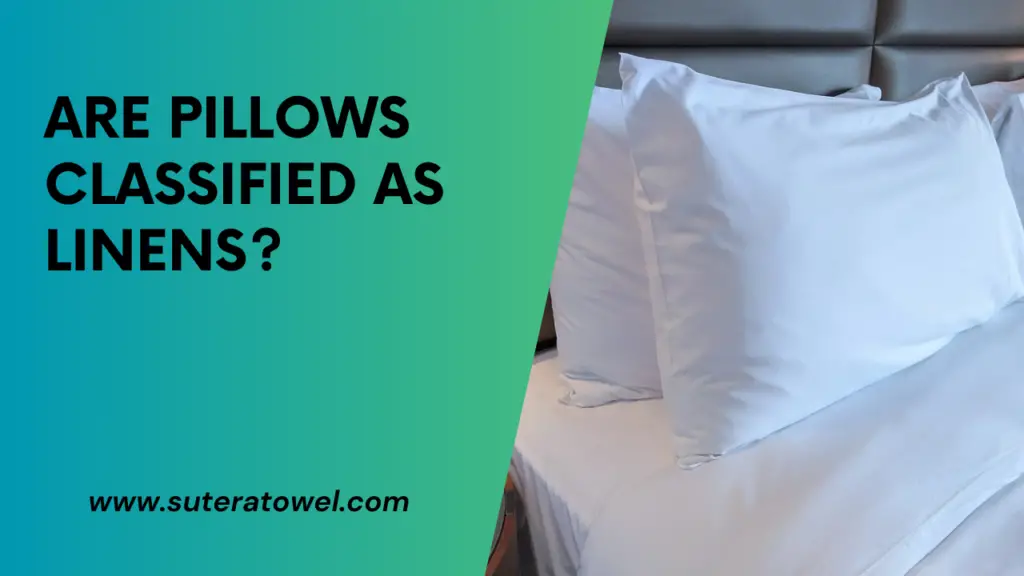Pillows are considered linens as they play a vital role in the bedding ensemble. Pillows are an essential part of our daily lives, providing comfort and support during sleep.
They are an integral component of the bedding ensemble, working alongside sheets, blankets, and other textile elements to create a cozy and inviting sleeping environment. But are pillows considered linens? The answer is a resounding yes. Linens encompass a broad category of textile products, including bed sheets, pillowcases, blankets, and, of course, pillows.
By definition, linens are items made from natural fibers or fabrics, typically used for bedding or other domestic purposes. We will delve deeper into the role of pillows as linens, exploring their benefits, types, and how they contribute to a restful night’s sleep. So, let’s dive into the world of pillows and discover why they are an indispensable part of any well-made bed.
- 1 What Defines Linens And Their Common Uses
- 2 Understanding Pillows: Their Purpose And Construction
- 3 The Relationship Between Pillows And Bed Linens
- 4 What Exactly Are Linens?
- 5 Are Pillows Classified As Linens?
- 6 Factors To Consider When Classifying Pillows As Linens
- 7 The Surprising Truth: Are Pillows Really Linens?
- 8 The Importance Of Proper Pillow Care
- 9 Frequently Asked Questions Of Are Pillows Considered Linens?
- 10 Conclusion
What Defines Linens And Their Common Uses

Pillows are indeed considered linens, as linens encompass all soft furnishings on a bed or in a bathroom. Linens’ common uses include providing comfort, enhancing decor, and promoting hygiene. Whether it’s pillowcases or bed linens, these items contribute to a cozy and inviting environment.
When it comes to home essentials, linens play a vital role in adding comfort and style to our living spaces. From bedding to tablecloths, linens are versatile and widely used in households. In this section, we’ll explore the characteristics that define linens and some common uses for them.
Characteristics That Define Linens
Linens are known for their distinct characteristics that set them apart from other materials. Here are some key features that define linen:
- Natural Fiber: Linens are typically made from natural fibers such as cotton, linen, or silk. These fibers give linens their soft, breathable, and hypoallergenic properties.
- Durable: Linens are known for their durability. They can withstand regular use and frequent washing without losing their shape or color.
- Absorbent: One of the notable qualities of linens is their absorbency. They can quickly and effectively absorb moisture, making them ideal for towels, napkins, and other items that come into contact with liquids.
Common Uses For Linens In Households
Linens have a wide range of uses in households, adding both functionality and aesthetics to various areas. Here are some common uses for linens:
- Bedding: Linens are commonly used for bedding, including sheets, pillowcases, duvet covers, and bedspreads. They provide a soft and comfortable surface for sleeping.
- Table Settings: Linens add an elegant touch to dining tables. Tablecloths, napkins, and placemats made from quality linens can enhance the dining experience and create a sophisticated atmosphere.
- Bathroom Essentials: Towels made of high-quality linens are known for their softness and absorbency. They are perfect for drying off after a shower or bath.
- Curtains and Window Treatments: Linen curtains can add a touch of elegance to any room. They provide privacy while allowing natural light to filter through, creating a warm and inviting ambiance.
- Decorative Pillows: Linen fabric is commonly used for decorative throw pillows. With its natural texture and versatile colors, linen can complement various interior styles and add a cozy feel to sofas or beds.
Linens are a valuable addition to any household, offering comfort, durability, and aesthetic appeal. From bedding to table settings, linens serve multiple purposes and elevate the overall look and feel of our living spaces. Embracing the charm of linens can transform your home into a cozy and stylish haven.
Understanding Pillows: Their Purpose And Construction

Pillows are often considered linens due to their use in bedding sets, but they serve a distinct purpose. Understanding the construction of pillows helps maximize their comfort and support for a good night’s sleep. So, while they may be grouped with linens, pillows offer unique benefits for sleep and relaxation.
Pillows play a crucial role in enhancing our sleep experience and ensuring optimal comfort. They are not just accessories for decoration; they serve a practical purpose in supporting our head, neck, and spine alignment while we rest. Different types of pillows exist, each with its own unique construction and material composition.
In this section, we will delve into the role and purpose of pillows, as well as explore the various types and their construction.
Are Towels Considered Linens? Discover the Truth
Role And Purpose Of Pillows:
Pillows serve several vital functions that contribute to a restful and comfortable sleep. Here are the key roles and purposes of pillows:
- Support: Pillows provide necessary support to the head, neck, and spine, promoting proper alignment while we sleep. This support aids in relieving pressure points and reducing strain on muscles and joints.
- Comfort: Pillows enhance overall comfort by cushioning the head and neck, allowing for a more relaxed sleep position. They contribute to a cozy and soothing sleep environment, ensuring that you wake up feeling refreshed.
- Posture Correction: By aligning the neck and spine correctly, pillows help improve posture, preventing any potential discomfort or pain caused by poor sleeping positions.
- Allergy Prevention: Some pillows are designed to be hypoallergenic, making them ideal for individuals with allergies or sensitivities. These pillows are created with materials that resist dust mites, mold, and other allergens, ensuring a healthier sleep environment.
- Temperature Regulation: Certain pillows are infused with cooling materials or have breathable designs, promoting airflow and dissipating heat. These features contribute to a cooler sleep experience, particularly for those who tend to sleep hot.
- Versatility: Pillows are not solely limited to bedtime use. They can also be utilized to enhance comfort while sitting or lounging, providing additional support for various activities.
Different Types Of Pillows And Their Construction:
When it comes to pillows, a wide range of options are available to cater to individual preferences and needs. Each type of pillow is constructed differently, utilizing specific materials and design elements to achieve its unique purpose. Here are some common types of pillows and a brief overview of their construction:
- Memory Foam Pillows: Constructed using memory foam, these pillows contour to the shape of your head and neck, providing customized support. They are known for their pressure-relieving properties and excellent spinal alignment.
- Down Pillows: Made from the soft inner plumage of ducks or geese, down pillows are renowned for their luxurious comfort. The feathers offer a lightweight and fluffy feel, and the pillow’s construction ensures a good balance between softness and support.
- Latex Pillows: Created from natural or synthetic latex, these pillows are known for their durability and resilience. They offer responsive support, and their open-cell structure promotes breathability and temperature regulation.
- Buckwheat Pillows: Filled with buckwheat hulls, these pillows provide adjustable and firm support. The unique filling allows for excellent airflow, preventing heat buildup and promoting a cooler sleep.
- Cotton Pillows: Made from natural cotton fibers, these pillows offer breathability and a soft feel. They are hypoallergenic, making them suitable for people with sensitivities or allergies.
- Polyester Fiberfill Pillows: Composed of synthetic fibers, these pillows are affordable and maintain their shape well. They provide a medium level of support and are often machine washable for easy maintenance.
- Contour Pillows: Designed with a unique shape to cradle the head and neck, contour pillows offer targeted support and alignment. They can be made from various materials, including memory foam and latex.
Understanding the role, purpose, and construction of pillows is essential when seeking a suitable option for your sleep needs. Each type of pillow brings its own advantages and considerations, allowing you to find the perfect match for your comfort preferences and desired level of support.
The Relationship Between Pillows And Bed Linens

Pillows and bed linens are not the same; pillows are not considered linens. While bed linens consist of sheets, pillowcases, and duvet covers, pillows are separate entities that provide support and comfort during sleep. However, pillows are an essential part of the overall bedding experience.
Overview Of The Connection Between Pillows And Bed Linens:
- Pillows and bed linens go hand in hand, forming an essential duo for a comfortable sleep experience.
- Bed linens include items such as bed sheets, pillowcases, duvet covers, and bed skirts, whereas pillows are cushioning additions to the bed.
- Together, pillows and bed linens create a cozy and inviting sleep environment.
How Pillows Are Commonly Used Alongside Bed Linens:
- Pillows are placed on the bed, usually at the head or beneath the head, in conjunction with the bed linens.
- They provide support and cushioning for the head, neck, and shoulders while sleeping.
- Pillows can be covered with pillowcases that match the bed sheets, adding a coordinated and aesthetically pleasing touch to the overall bedding ensemble.
The Impact Of Pillows On Sleep Quality And Comfort:
- Pillows play a crucial role in enhancing sleep quality and comfort.
- They provide proper alignment and support for the neck and spine, helping to alleviate neck and back pain.
- Pillows also aid in relieving pressure points, reducing tossing and turning during the night, and promoting deep sleep.
- The right pillow can make a significant difference in sleep quality, ensuring a restful and rejuvenating slumber.
By understanding the relationship between pillows and bed linens, we can appreciate the importance of both in creating an optimal sleep environment. Pillows, along with bed linens, contribute to sleep quality, comfort, and overall well-being. So, next time you make your bed, remember to choose pillows that complement your bed linens and provide the support you need for a good night’s sleep.
What Exactly Are Linens?
Pillows are not considered linen. Linens refer to items made from fabric, such as bedsheets, towels, and tablecloths. While pillows may be covered with fabric, they are not typically categorized as linens.
Linens are a common household item that we often take for granted. We use them every day without giving much thought to what they actually are. But have you ever wondered if, are considered linens? To answer that question, we first need to understand exactly what linens are.
In this section, we will delve into the definition of linens, explore their historical background, discuss the materials commonly used to make them, and finally, distinguish them from other fabrics.
Defining Linens And Their Historical Background:
- Linens are textiles made from natural fibers, typically derived from plants like flax, hemp, or cotton.
- They are known for their softness, breathability, and moisture-wicking properties.
- Linens have been used for centuries in various cultures around the world due to their durability and practicality.
Materials Commonly Used To Make Linens:
- Flax: Linen fabric is primarily made from flax fibers, which are derived from the inner bark of the flax plant.
- Cotton: While cotton is not traditionally considered a linen fabric, it is often used to make bed linens due to its comfort and affordability.
- Hemp: Hemp fibers can also be used to create linen-like fabrics, offering similar benefits to traditional linen.
The Distinction Between Linens And Other Fabrics:
- Linens are often differentiated from other fabrics based on their natural, plant-based fibers, as opposed to synthetic or animal-derived fibers.
- Unlike synthetic fabrics like polyester or nylon, which are petroleum-based, linens are more eco-friendly and sustainable.
- Linens are also distinct from silk, which is derived from the cocoon of silkworms, and wool, which is sourced from sheep or other animals.
As we’ve explored, linens are textiles made from natural fibers, such as flax, cotton, or hemp. They have a rich historical background and are cherished for their softness, breathability, and moisture-wicking properties. Linens differ from other fabrics in their composition and ecological impact.
So the next time you snuggle up with your favorite pillow, you’ll know whether or not it falls under the umbrella of linens.
Are Pillows Classified As Linens?

Pillows are commonly classified as linens due to their association with bedding and the fact that they are often made from fabric materials. However, the classification can vary depending on individual categorizations and personal preferences.
Pillows have always been an essential part of our sleeping experience, providing comfort and support to our tired bodies at the end of each day. But when it comes to their classification, there seems to be some debate. Are pillows considered linens?
Let’s explore different perspectives, examine their material and usage characteristics, and delve into the influence of cultural and regional factors in determining these classifications.
Different Perspectives On Whether Pillows Are Considered Linens:
- Pillows are linens:
- Pillows are commonly included in the category of bedding, which falls under the broader umbrella of linens.
- They are often made from fabric materials that are used for other textile products considered linens, like sheets and duvets.
- Pillows serve a similar purpose as other linens by enhancing comfort and hygiene in our sleeping environments.
- Pillows are not linens:
- Some argue that linens strictly refer to flat pieces of fabric used for bedding, such as bed sheets and pillowcases.
- Unlike traditional linens, pillows are filled with materials like memory foam, down, or polyester fibers, which differentiates them from flat textiles.
- Pillows have a three-dimensional shape and are distinctively designed to provide support to the head and neck.
Examining The Material And Usage Characteristics Of Pillows:
- Material characteristics:
- Pillows are often covered in a removable pillowcase made from various fabrics such as cotton, silk, or microfiber.
- The pillow-filling materials can vary, including memory foam, down feathers, synthetic fibers, or even natural materials like buckwheat hulls.
- The choice of materials contributes to the overall comfort, breathability, and durability of the pillow.
- Usage characteristics:
- Pillows are commonly used for sleeping, lounging, or supporting different body parts, promoting proper alignment and relieving pressure points.
- Decorative pillows, often embellished with unique designs, are used purely for aesthetic purposes to enhance the appearance of a space.
The Influence Of Cultural And Regional Factors In Determining Classifications:
- Cultural factors:
- Different cultures may have varying views on what constitutes linen, influenced by their traditional practices and beliefs.
- In some cultures, pillows may hold a more significant symbolic and cultural value, blurring the lines between their classification as linens.
- Regional factors:
- The classification of pillows as linens can also vary regionally, as countries may have specific guidelines or traditions regarding bedding classification.
- Regional preferences for pillow types, such as softer or firmer pillows, may impact how they are viewed and categorized.
While perspectives differ on whether pillows should be considered linens, they are undoubtedly closely related to the world of textiles and bedding. With their material and usage characteristics, as well as the influence of cultural and regional factors, pillows bring comfort, style, and functionality to our sleep experience.
So, whether we refer to them as linens or not, we can all agree on their importance in promoting a good night’s rest.
Factors To Consider When Classifying Pillows As Linens
Pillows are typically classified as linens due to their fabric and their function in providing comfort and support during sleep. Factors to consider include the pillow’s material, construction, and intended use.
Are Pillows Considered linen?
Pillows are an essential part of our everyday lives, providing comfort and support while we sleep or relax. But are they considered linen? In this blog post, we will delve into the factors that determine whether pillows can be classified as linens.
By analyzing their physical and functional attributes and comparing them to other traditionally classified linen items, we can gain a better understanding.
Key Considerations In Determining If Pillows Should Be Classified As Linens:
- Material composition: Pillows are often made from fabric, such as cotton or polyester, which are common materials used in linens.
- Usage: Pillows are primarily used for sleeping, just like bed sheets and pillowcases, which are considered linens.
- Association with bedding: Pillows are closely associated with bedding, and often used together with sheets and pillowcases, further supporting their classification as linens.
- Cleaning and care: Pillows require regular washing, similar to other linens, to maintain hygiene and freshness.
- Placement on the bed: Pillows are typically placed on the bed alongside other linens, reinforcing their classification as part of a bedding set.
Analysis Of The Physical And Functional Attributes Of Pillows
- Softness and comfort: Pillows are designed to provide a soft and comfortable surface for resting our heads, just like other linens that offer comfort and coziness.
- Support: Pillows offer support to our neck and head, ensuring proper alignment and reducing discomfort, much like the support provided by pillows in a pillowcase or beneath a sheet.
- Size variations: Pillows come in various sizes, similar to bed linens that offer options for different bed sizes.
- Versatility: Pillows are not limited to just beds; they can be found on sofas, chairs, and other seating areas. This versatility aligns with the functionality of linens used to enhance comfort in various settings.
Comparing Pillows To Other Items Traditionally Classified As Linens
- Pillowcases: Just like pillowcases, pillows are used for sleeping and are made from similar materials, reinforcing their classification as linens.
- Bed sheets: Bed sheets and pillows are often used together, serving the same purpose of providing comfort and support during sleep.
- Blankets and throws: While pillows may differ in function, they share similarities with blankets and throws in terms of providing comfort and coziness, further aligning them with the category of linens.
Based on the key considerations in determining the classification of pillows as linens, along with the analysis of their physical and functional attributes and a comparison to other traditionally classified linen items, it is evident that pillows can indeed be considered linens.
They share similar characteristics, utility, and usage patterns with other items in the linen category, making them a valuable component of our bedding ensemble.
The Surprising Truth: Are Pillows Really Linens?
Pillows, though commonly found alongside linens, are not technically considered linens themselves.
Pillows – those soft, comforting objects we rest our weary heads upon every night. They are an essential part of our sleep routine, but have you ever wondered if they are considered linens? The answer may surprise you. In this section, we will analyze the arguments for and against categorizing pillows as linens, evaluate the criteria used to classify linens, and ultimately determine whether pillows can be classified as linens or not.
Analyzing The Arguments For And Against Categorizing Pillows As Linens:
- Argument for: Pillows are made from fabric: Pillows are generally made from fabric materials such as cotton, polyester, or a blend of various fibers.
- Argument for: Pillows serve a similar purpose as other linens: Just like bedsheets and pillowcases, pillows enhance our comfort while sleeping and contribute to our overall sleep experience.
- Argument against: Pillows have a different function: Unlike other linens, pillows are not used directly on the body or in contact with the skin. They are positioned as a supportive element for the head and neck.
Evaluating The Criteria Used To Classify Linens:
- Material composition: Traditional linens are typically made from natural fibers such as cotton, linen, or silk. Although pillows are made from fabric, they can also be filled with synthetic materials like foam or polyester, which deviate from the composition of traditional linens.
- Usage: Linens are commonly used for personal hygiene, such as bedsheets, towels, and washcloths. On the other hand, pillows primarily fulfill a sleep support function rather than being used directly for personal cleanliness.
- Association with bedding: Linens are often associated with bedding items that come into close contact with the body, such as sheets and pillowcases. While pillows are used in conjunction with bedding, they are not typically considered an integral part of it.
Conclusion On Whether Pillows Can Be Classified As Linens:
Although pillows share some similarities with linens, such as being made from fabric and contributing to sleep comfort, they ultimately do not meet the criteria traditionally associated with linens. Pillows serve a distinct purpose, offering support for the head and neck, rather than being used directly on the body or associated with personal hygiene.
Therefore, while pillows may be considered an essential component of bedding, they are not typically classified as linens.
So, next time someone asks if pillows are considered linens, you can astonish them with the surprising truth and enlighten them about the nuances that differentiate pillows from traditional linens.
The Importance Of Proper Pillow Care
Proper pillow care is of utmost importance to maintain their longevity and hygiene. Although pillows are not technically considered linens, they still require regular cleaning and maintenance to ensure a good night’s sleep. Keep your pillows clean and fresh by following care instructions and investing in pillow protectors.
Pillows are an essential part of our sleep routine, providing much-needed comfort and support for a good night’s rest. But did you know that proper care and maintenance of your pillows are just as important as the pillows themselves? In this section, we will explore the reasons why taking care of your pillows is crucial for their longevity and hygiene.
We will also discuss best practices for cleaning and storing your pillows to ensure they stand the test of time.
Promoting Proper Care And Maintenance Of Pillows:
- Regularly fluffing your pillows: This helps distribute the filling evenly and maintains their shape for optimal comfort.
- Using pillow protectors: These covers act as a barrier against sweat, oils, and allergens, keeping your pillows clean and fresh.
- Avoiding eating or drinking in bed: Limiting food and beverages on your pillow can prevent stains and the potential for attracting pests.
- Keeping pets off pillows: As much as we love our furry friends, their presence on pillows can lead to unwanted smells, stains, and allergens.
Best Practices For Cleaning And Storing Pillows:
- Machine washing: Check the care label, but most pillows can be safely washed in a machine. Use a gentle cycle and mild detergent. Adding a second rinse helps remove any soap residue.
- Drying pillows: Tossing them in the dryer on a low heat setting with a couple of clean tennis balls or dryer balls helps fluff and prevent clumping of the filling.
- Sunning pillows: Occasionally, let your pillows soak in the sun to naturally freshen them up and eliminate any lingering odors.
- Proper storage: When not in use, store your pillows in a clean, dry place to protect them from dust, moisture, and pests. Avoid storing them in plastic bags, as this can trap moisture and encourage mold growth.
The Impact Of Pillow Care On Longevity And Hygiene:
- Prolonged pillow lifespan: Regular care ensures that pillows maintain their support and shape, preventing premature flattening or lumpiness.
- Improved sleep quality: A clean and fresh pillow can contribute to a more pleasant sleeping experience, free of allergens and unpleasant odors.
- Hygienic benefits: Proper pillow care reduces the buildup of sweat, body oils, and allergens, which can lead to respiratory issues and skin irritations.
Taking the time to promote proper care and maintenance of your pillows will not only extend their lifespan but also enhance your overall sleeping environment. By following these best practices for cleaning and storing your pillows, you can enjoy a restful and hygienic sleep for years to come.
Frequently Asked Questions Of Are Pillows Considered Linens?
Do Pillows Count As linen?
Yes, pillows are considered linens for bedding purposes.
Are Pillows Considered Bedding?
Yes, pillows are considered bedding. They provide comfort and support during sleep.
What Are Considered Linens?
Linens refer to household items and fabrics, such as bed sheets, pillowcases, and tablecloths.
Is Pillow Case A Bed Linen?
Yes, a pillowcase is considered a type of bed linen.
Conclusion
Pillows are indeed considered linens due to their role in the bedroom. They play a critical role in enhancing comfort and ensuring a good night’s sleep. Pillows come in various materials and designs, catering to different preferences and needs. From memory foam to down feather pillows, each type contributes to providing the necessary support and relaxation for the body and mind.
Additionally, pillows can also be a stylish addition to bedroom decor, serving both functional and aesthetic purposes. With their wide availability and versatility, pillows have become an essential part of the bedding ensemble, often included as part of a complete set of linens.
So, the next time you’re shopping for linens, don’t forget to include pillows in your list. They not only add beauty to your bed but also significantly contribute to your sleep quality and overall well-being.
